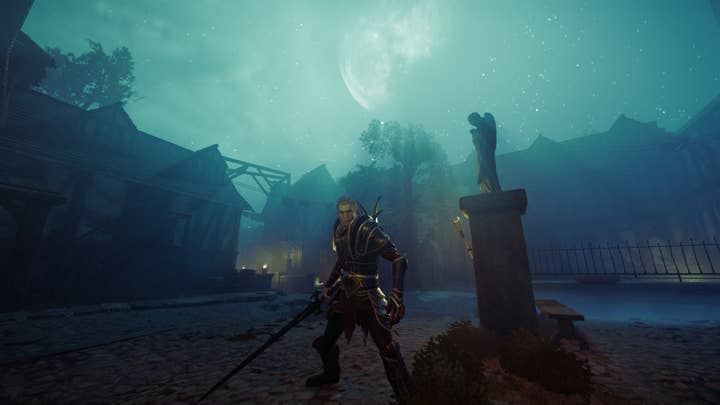What is the best game engine: is Amazon Lumberyard right for you?
The GamesIndustry.biz Academy's in-depth guide to Lumberyard, a 3D engine powered by Amazon Web Services
Update: Lumberyard is no longer offered by Amazon following the announcement of Open 3D Engine in July 2021.
For developers just starting in the industry, the task of choosing the best game engine can be daunting. Here, we'll try to address many of the issues concerning Amazon Lumberyard, so you can see if it's the right game engine for your project.
You can read our other in-depth guides on all the major game engines on this page.
Amazon's involvement in games has grown exponentially since its first foray in 2008 with the acquisition of Reflexive.
The announcement of its cloud gaming service, Luna, earlier this year, is the culmination of years of trial and error. From its Kindle Fire days in 2011 to the acquisition of Double Helix in 2014, from Amazon Underground and the development of its first game in 2015, to the unfortunate fate of Crucible this year, the tech giant has seen highs and lows.
But one aspect of its gaming business that's been growing steadily is its development engine. Amazon launched Lumberyard in 2016, as a free 3D game engine. The development tool is based on Crytek's CryEngine, which Amazon licensed in April 2015 for an undisclosed sum rumoured to be between $50 and $70 million.

But Amazon Lumberyard now stands firmly on its own feet, having progressively moved away from CryEngine. Since its initial release, 70% of the original code base has been overhauled, Amazon recently said. The engine is still in beta and the latest iteration, 1.26, released in October 2020.
"There's a common perception from people that Lumberyard is basically CryEngine, but this is out of date," says Matthew Jack, CEO and lead architect at AI middleware and development services company Kythera. "Most of the engine has already been rewritten and, as CryEngine experts, it now feels completely different to use and develop for."
Lumberyard's native integration of Amazon Web Services and Twitch are among its unique selling points. But if you still hesitate between the two, you can head to our CryEngine guide to read a refresher.
Unlike CryEngine, Lumberyard doesn't rely on a royalties system -- it's a free engine, including its source code. That's because its monetisation is driven by Amazon Web Services fees, which vary depending on which tools developers choose to use (if any). In July 2021, Amazon announced that the engine was going open source, under the name Open 3D Engine (O3DE) under the Apache 2.0 license. A developer preview is already available on GitHub, with the full release planned for late 2021.
Lumberyard is a cross-platform engine skewed towards AAA development. It currently supports PlayStation 4, Xbox One, PC (Windows and Linux), iOS and Android. Additional support for MacOS is in the works. The engine also supports VR ecosystems such as Oculus Rift, HTC Vive, and PlayStation VR. It's worth noting that developers need to be licensed by Sony and Microsoft to proceed with their respective hardware.
In terms of programming languages supported, Lumberyard uses both C++ and Lua.

Lumberyard targets the same kind of development studios as Unreal and CryEngine then, but it hasn't enjoyed the same popularity so far. Amazon doesn't share user base figures, but last year Gamasutra published a list of the most commonly used game engines on Steam, analysing the data of 49,281 games as of December 2018. While the results are imperfect and, to some extent, dated, Lumberyard did not appear on the list at all.
But there is still a small community of strong Lumberyard supporters, with some seriously ambitious games currently developed using Amazon's technology, such as Cloud Imperium Games' Star Citizen. And while Lumberyard has currently very few released games, its evolution from CryEngine and "expectations of great things from Amazon" is what convinced Kythera to support Lumberyard.
"In particular, their emphasis on cloud services could open up a lot of possibilities for large scale AI and really reactive development tools," Jack says.
What are the advantages of Lumberyard?
- Lumberyard is highly flexible
Lumberyard is capable of producing AAA games with high fidelity 3D graphics, which makes it a natural fit for big projects. However, adaptability has become part of its DNA, making it suitable for all kinds of projects.
"At launch, Lumberyard was used as mainly a first-person-shooter engine," says Sweet Bandits co-founder Charles Dufour. "However, with the added component system and full access to code, we made a 2D fighting game with it named Coffence. Right now, we are using Lumberyard for Deceive Inc, an online first-person spy game and I can safely say that it is a good fit for that.
"Lumberyard evolved into a very adaptable engine. We've seen solid momentum with major product improvements"Charles Dufour, Sweet Bandits
"Over the years, I think Lumberyard evolved into a very adaptable engine, due to the ease of use of the tools, integration of AWS, a solid visual scripting system and complete access to source code to modify the engine to the needs of the project. We've seen solid momentum with major product improvements with recent updates, which is a promising sign for the future."
One of the tools that allows for Lumberyard's modularity is its Gems system -- packages that contain code and assets. It lets developers choose the features they want without having to take in tools they don't need. You can learn more about it on this page.
"[The] Gems system [allows] the engine to be almost entirely modular," says Denis Dyack, CEO at Apocalypse Studios. "This means that if your team does not need a particular feature of the engine, you can remove it from the engine and no longer need to compile it."
Lumberyard can essentially be seen as a blank canvas for developers to use as they please.
"As a native engine with full source, Lumberyard provides a performant foundation for our studio to build, and improve our game tech over time," says Travis Boatman, CEO at Carbonated Games.

- Lumberyard excels at services-heavy games
Amazon's engine provides a robust ecosystem of online tools and services that are integrated seamlessly, making it a good choice for cloud games or titles with social components.
Lumberyard comes with Amazon Web Services out-of-the-box, the leader of the cloud infrastructure services market, and it can also leverage GameLift. The latter goes hand-in-hand with AWS, as "a service for deploying, operating, and scaling dedicated game servers for session-based multiplayer games."
And then, of course, Twitch is fully integrated in Lumberyard, since Amazon bought the livestreaming company in 2014.
"When Apocalypse first formed, we evaluated all of the available engines," Dyack says. "We were searching for an engine that would allow us to create a game for the cloud, deep social media integration, and the highest quality standards. We compared support, cost, features, and the long term outlook of all of the engines. Amazon Lumberyard outperformed all of the other engines when combining these categories."
"As an indie studio, we needed to have tools that worked with us rather than against us"Charles Dufour, Sweet Bandits
Boatman says that Carbonated's current project, Madworld: State of Survival, a real-time multiplayer game that takes place in a 3D outside environment, is "services-heavy." That made Lumberyard a great fit for the project.
The inclusion of so many features also means that developers can focus on what matters the most: the game.
"The full integration of AWS services means that you can leverage top-tier online services for your game and concentrate on game mechanics and features rather than on the back-end services," Dufour says. "As an indie studio, we knew that we would be working with smaller teams than what we were used to, so we needed to have tools that worked with us rather than against us."
- Lumberyard has beginner-friendly tools
Like most of its counterparts such as Unreal with Blueprint or Unity with Bolt, Lumberyard has a visual scripting system, called Script Canvas. It enables anyone to prototype or deliver game logic without having to learn a scripting language.
"The Script Canvas technology is a really powerful visual scripting tool for game designers," says Philipp Dziuba, development director at Frag Lab. "It allows us to create and iterate prototypes really fast, and even finalise game mechanics without any code support. One of the biggest advantages of Script Canvas is its really easy learning curve."
This makes Lumberyard a user-friendly tool and once again highlights its modularity.
"Through it's customisation and flexibility, the engine allows for developers to create prototypes efficiently while also providing the tools and frameworks to develop projects of higher scale," Dyack says.

- Lumberyard is free
One of Lumberyard's biggest advantages is its pricing. As Kythera's Matthew Jack puts it: "Given some constraints, it's free!"
The constraints Jack is referring to are that users do need to pay for using AWS, should they need its services. But if you are not in need for online components, it'll be completely free of charge or royalty, and you don't even need an AWS account.
Of course, AWS integration is one of the engine's biggest draws, so if you're not working on an online game, you may want to have a look at other engines.
"Being royalty-free is a considerable advantage, meaning that the engine will be one less dent in the potential profits for your game," Dufour says.
If your project requires Amazon Web Services, the company has an AWS Pricing Calculator to create an estimate based on your needs. Fees vary over time and depending on location.
For instance, if you have the need for storage in the cloud via AWS, it'll cost you $0.026 per gigabyte for the first 50 terabytes if you're based in Northern California, or $0.023 per gigabyte if you're based in Stockholm. If you use Amazon GameLift on Windows, a monthly spot with autoscaling will cost you $49.06 if you're in Ohio, versus $59.04 per month if you're in Sao Paulo, at the time of writing.
You can learn more about GameLift's pricing on this page, and more generally about AWS' pricing here.
"Amazon is a truly client oriented company, and they care about the developers' problems, issues and requests"Philipp Dziuba, Frag Lab
- Amazon provides excellent support
Despite being owned by one of the biggest companies on the planet, Lumberyard is still small. Paradoxically, that works in users' favour when it comes to official support.
"We've never seen such a great level of support from an engine developer -- and trust us, a big part of our team has worked in companies with their own AAA engines, so we know how it can be," says Dziuba. "Amazon is a truly client oriented company, and they care about the developers' problems, issues and requests. We have a number of examples when Amazon changed their priorities and even set up new teams to meet our needs in the development of our MMO FPS title."
This was the unanimous feeling expressed by Lumberyard developers we talked to. Dyack was also allocated engineers from Amazon to help solve technical issues on a project.
"Amazon consults with us often to determine what kind of direction we want to see for new features and improvements to existing features, and has even implemented some of our code changes into the mainline of the engine, which is very exciting from our end," he says.
Dufour adds: "Being able to directly reach out to an engine development team and influence their roadmap is something we couldn't imagine with other engines."

- Lumberyard's upgrades are easy to implement
Integration of newer versions of Lumberyard is very easy, which is an undeniable advantage for an engine that is still in beta and gets regular updates.
"Lumberyard architecture allows developers to extend the engine with Gems and EBus concepts without heavy injection into the code itself," Dziuba explains. "It makes the integration of new Lumberyard versions way easier, so you can get new engine features without breaking what you've already implemented. Frag Lab started development with the now-obsolete Lumberyard v1.8, but we effortlessly updated to current versions of the engine, and will continue to do so."
Being able to update seamlessly and build upon the engine without impacting its core is a crucial requirement for live games with a long lifecycle, Frag Lab's technical director Sergey Rustamov continues.
"The continuous evolution is in Lumberyard's DNA. It [now] supports Visual Studio 2019. The newly introduced Platform Abstraction Layer concept makes it possible to develop a highly portable code, which is crucial when your game supports console platforms."
What are the disadvantages of Lumberyard?
- Lumberyard is not meant for simple projects
By now you will have gathered that Lumberyard is a hefty engine, suitable to handle big projects with a lot of online components.
"A team wanting to make a retro pixel-art game would have a harder time creating their game in Lumberyard"Charles Dufour, Sweet Bandits
Apocalypse Games is currently using it to develop Deadhaus Sonata, a live co-op multiplayer action-RPG with direct Twitch integration. Carbonated Games' Madworld is real-time player-versus-player leveraging GameLift. Frag Lab is working on a free-to-play online FPS. Sweet Bandits' Deceive Inc is a multiplayer spy game.
These studios all have been created by former AAA staff, with experience at the likes of Activision Blizzard, Electronic Arts, and Crytek. So if your project is a 2D indie game, you may want to look elsewhere -- at engines such as GameMaker, Monogame, Construct, or Godot.
"[Lumberyard] is a 3D engine with a sophisticated renderer, so a team wanting to make a retro pixel-art game would have a harder time creating their game in [it]," Dufour says.
Rustamov advises to consider the scale and nature of your game before proceeding with Amazon's engine.
"Lumberyard in a nutshell is a good choice for a massive MMO product with global presence," he says. "Lumberyard's asset processing system and internals are best suited for big, highly flexible game companies with different types of teams and a huge amount of content."

- Lumberyard doesn't have many online resources
Due to its smaller user base -- compared to Unity or Unreal -- Lumberyard doesn't have a lot of channels where you can find help and documentation. And when you do find resources, they may become obsolete quite fast.
"As a newer initiative and entrant into the engine space, there is less community support and third-party documentation available," Boatman says. "The community for this engine -- in that it's both native and relatively new -- is smaller than older engines."
Dufour points out that, while community support is good, it would "benefit greatly from more users adopting the engine." This means that the learning curve can be quite steep for inexperienced developers.
Dyack adds: "Lumberyard is going through significant changes and updates regularly, and thus documentation is often outdated."
- Recruiting for Lumberyard can be challenging
Lumberyard has yet to be embraced at a large scale, meaning that if you're putting together a team for an ambitious project, it may be difficult to find recruits who have experience with Amazon's engine.
"To this day, we never found a potential recruit that had experience with Lumberyard"Charles Dufour, Sweet Bandits
"To this day, we never found a potential recruit that had experience with Lumberyard," Dufour says. "But quite frankly, being functional with the engine roughly takes a week so, instead, we look for competencies and general game industry experience."
Dyack confirms that finding people experienced in Lumberyard is currently rare, but that the concepts behind Amazon Lumberyard are consistent with other engines. But while senior developers should become familiar with Amazon's tools easily, inexperienced recruits may find its learning curve steep, making recruitment at both ends of the spectrum arduous.
"Native engines with full source could be challenging for less experienced teams who might not be comfortable modifying or creating new features at the engine level," Boatman says. "As a AAA engine designed for higher end development projects, it's more challenging to onboard new employees who are unfamiliar with lower level C++ development or spelunking into engine source code."

- Lumberyard is not fully mature
Lumberyard is still in beta, and there's currently no hard release date on the horizon, meaning there's an inherent risk with adopting it as your engine of choice.
"Lumberyard is still a work in progress, not fully mature," Jack says.
"Lumberyard is still a work in progress, not fully mature"Matthew Jack, Kythera
For instance, there's very little AI support out of the box, he continues, while Rustamov adds that you might need to spend some manpower to make sure it all runs smoothly, as some parts of the engine are still in early development phase.
"Despite growing engine stability you will still have to allocate a dedicated internal engine development team to manage game-specific modifications and updates," he says. "You also have to consider that the engine is currently nearing completion of Cry legacy deprecation, and your team should be ready to use the new functionality, even if it's in preview state."
Advice for new Lumberyard users
- Get hands on and test your concept
When it comes to free engines, the best thing to do if you're unsure is to try it for yourself.
"I'd recommend that [new users] download the engine and they go through its tutorial documentation, to get some hands-on experience with the tools and also to understand the principles of the engine," Dufour says.
- Reach out to the community
Once you're accustomed to the engine, take your efforts a bit further and reach out to the community, or the Lumberyard dev team, to validate your project. Connecting with the community is a great way to find tricks and tips, and discuss development methods.
"The engine is designed and built for the future of gaming, utilising AWS and the cloud to the fullest"Denis Dyack, Apocalypse Studios
"It might be a good idea to go into the support forum and start a thread with the community there to figure if [your] game concept is a good fit for the engine," Dufour continues. "Back in 2016 we reached out to the Lumberyard dev team and made some contacts to get some help with starting with the engine. At first, we relied on these contacts and the written documentation -- including the one from Crytek -- to get started.
"Now we regularly post topics on the official support forum which is our main method for support, but we also use the Discord channel to get some quick tips on how to resolve our issues. There is also the Github repository that can sometimes get us some community fixes on issues with the engine."
There's also an official YouTube channel, tutorials on how to get started on AWS' website, and Lumberyard's documentation site. There's a FAQ on this page as well.
Overall, while Lumberyard is a work in progress that doesn't benefit from a huge community, the developers we talked to all bet on the engine's future -- with cloud games being more and more prominent, choosing an engine that natively supports AWS is an undeniable selling point that has huge potential.
"We believe that all developers should look into Lumberyard for their future development," Dyack concludes. "The price point and support are unmatched, and the engine is designed and built for the future of gaming, utilizing AWS and the cloud to the fullest."
Our in-depth guides on all the major game engines can help you find the best technology for your game -- the page will be regularly updated to add new engines to the list. If you're eyeing the most popular game engines, you can jump to our Unity guide right away, or read more about Unreal Engine here.
More GamesIndustry.biz Academy guides to Making Games
Our guides to making games cover various aspects of the development process, whether you're a young game developer about to start a new project or an industry veteran:

